2016 SUBARU IMPREZA tow
[x] Cancel search: towPage 501 of 594
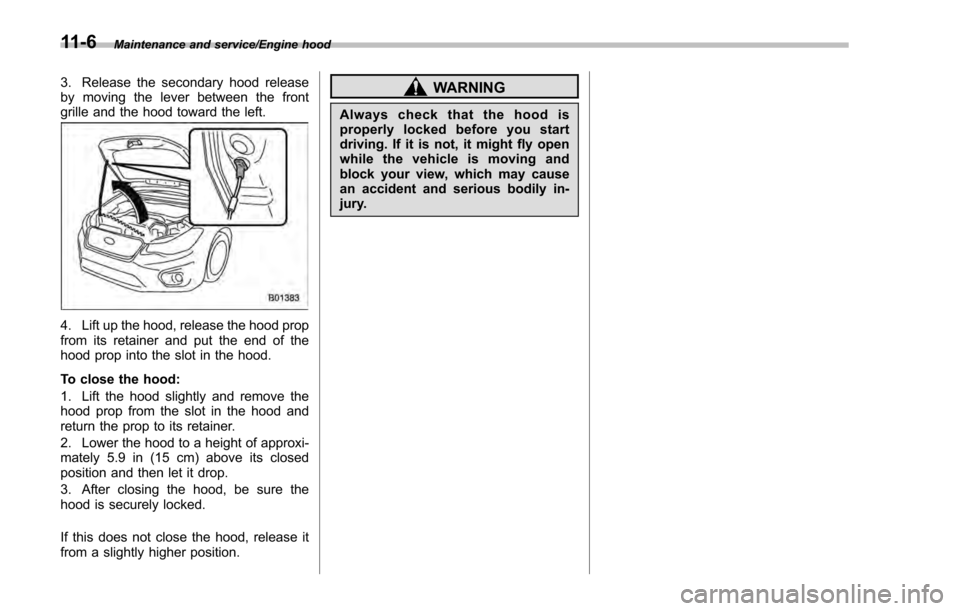
Maintenance and service/Engine hood
3. Release the secondary hood release
by moving the lever between the front
grille and the hood toward the left.
4. Lift up the hood, release the hood prop
from its retainer and put the end of the
hood prop into the slot in the hood.
To close the hood:
1. Lift the hood slightly and remove the
hood prop from the slot in the hood and
return the prop to its retainer.
2. Lower the hood to a height of approxi-
mately 5.9 in (15 cm) above its closed
position and then let it drop.
3. After closing the hood, be sure the
hood is securely locked.
If this does not close the hood, release it
from a slightly higher position.
WARNING
Always check that the hood is
properly locked before you start
driving. If it is not, it might fly open
while the vehicle is moving and
block your view, which may cause
an accident and serious bodily in-
jury.
11-6
Page 503 of 594
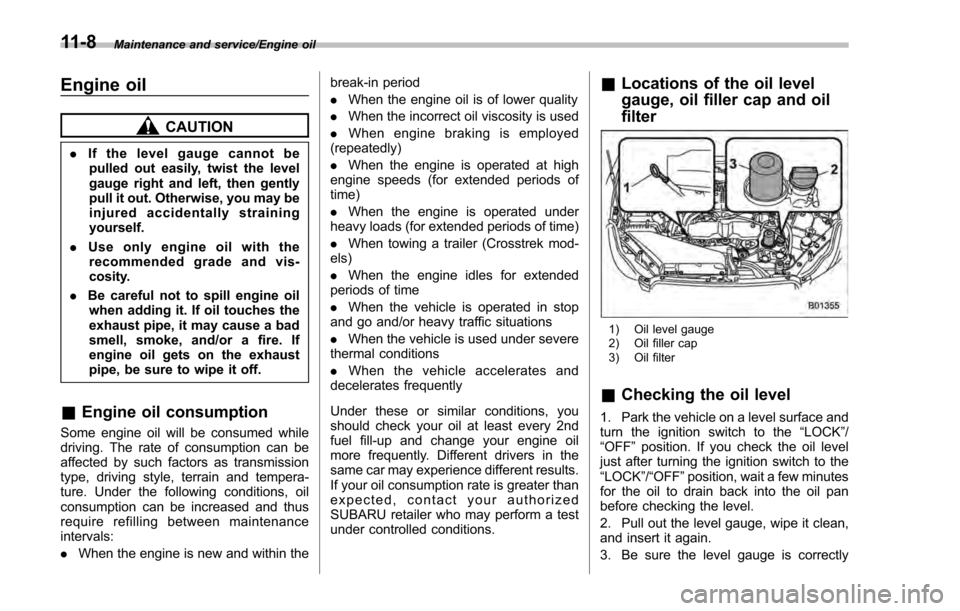
Maintenance and service/Engine oil
Engine oil
CAUTION
.If the level gauge cannot be
pulled out easily, twist the level
gauge right and left, then gently
pull it out. Otherwise, you may be
injured accidentally straining
yourself.
. Use only engine oil with the
recommended grade and vis-
cosity.
. Be careful not to spill engine oil
when adding it. If oil touches the
exhaust pipe, it may cause a bad
smell, smoke, and/or a fire. If
engine oil gets on the exhaust
pipe, be sure to wipe it off.
& Engine oil consumption
Some engine oil will be consumed while
driving. The rate of consumption can be
affected by such factors as transmission
type, driving style, terrain and tempera-
ture. Under the following conditions, oil
consumption can be increased and thus
require refilling between maintenance
intervals:
. When the engine is new and within the break-in period
.
When the engine oil is of lower quality
. When the incorrect oil viscosity is used
. When engine brakin g is employed
(repeatedly)
. When the engine is operated at high
engine speeds (for extended periods of
time)
. When the engine is operated under
heavy loads (for extended periods of time)
. When towing a trailer (Crosstrek mod-
els)
. When the engine idles for extended
periods of time
. When the vehicle is operated in stop
and go and/or heavy traffic situations
. When the vehicle is used under severe
thermal conditions
. When the vehicle accelerates and
decelerates frequently
Under these or similar conditions, you
should check your oil at least every 2nd
fuel fill-up and change your engine oil
more frequently. Different drivers in the
same car may experience different results.
If your oil consumption rate is greater than
expected, contact your authorized
SUBARU retailer who may perform a test
under controlled conditions.
& Locations of the oil level
gauge, oil filler cap and oil
filter
1) Oil level gauge
2) Oil filler cap
3) Oil filter
&Checking the oil level
1. Park the vehicle on a level surface and
turn the ignition switch to the “LOCK”/
“OFF ”position. If you check the oil level
just after turning the ignition switch to the
“LOCK ”/“OFF ”position, wait a few minutes
for the oil to drain back into the oil pan
before checking the level.
2. Pull out the level gauge, wipe it clean,
and insert it again.
3. Be sure the level gauge is correctly
11-8
Page 527 of 594
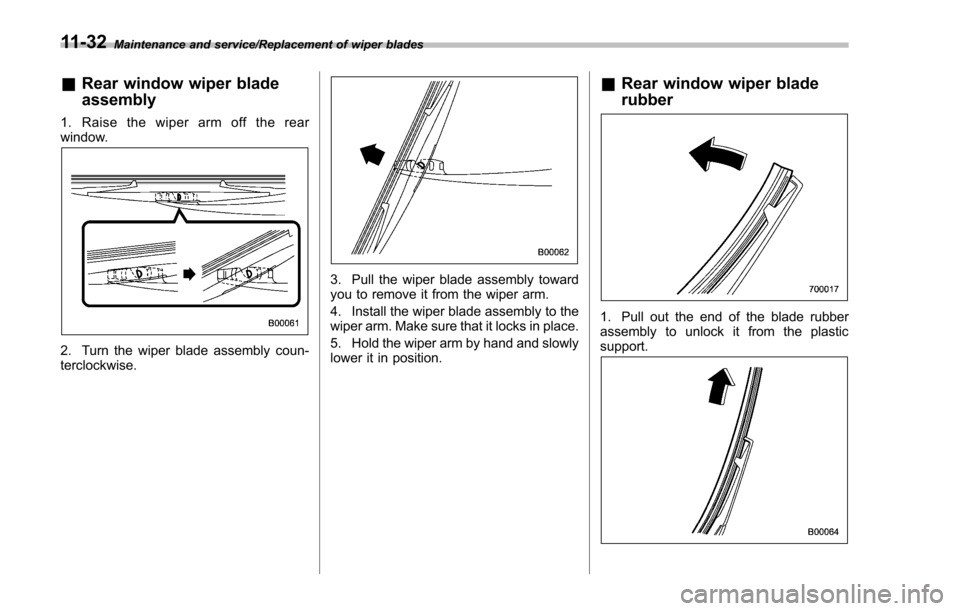
Maintenance and service/Replacement of wiper blades
&Rear window wiper blade
assembly
1. Raise the wiper arm off the rear
window.
2. Turn the wiper blade assembly coun-
terclockwise.
3. Pull the wiper blade assembly toward
you to remove it from the wiper arm.
4. Install the wiper blade assembly to the
wiper arm. Make sure that it locks in place.
5. Hold the wiper arm by hand and slowly
lower it in position.
&Rear window wiper blade
rubber
1. Pull out the end of the blade rubber
assembly to unlock it from the plastic
support.
11-32
Page 569 of 594

Consumer information and Reporting safety defects/Tire information
&Tire care –maintenance and
safety practices
.Check on a daily basis that the
tires are free from serious damage,
nails, and stones. At the same time,
check the tires for abnormal wear.
.Inspect the tire tread regularly
and replace the tires before their
tread wear indicators become visi-
ble. When a tire ’streadwear
indicator becomes visible, the tire
is worn beyond the acceptable limit
and must be replaced immediately.
With a tire in this condition, driving
at even low speeds in wet weather
can cause the vehicle to hydro-
plane. Possible resulting loss of
vehiclecontrolcanleadtoan
accident.
.To maximize the life of each tire
and ensure that the tires wear
uniformly, it is best to rotate the
tires every 7,500 miles (12,000 km).
For information about the tire rota-
tion order, refer to “Tire rotation ”
F 11-26
.Replace any damaged or
unevenly worn tires at the time of rotation. After tire rotation, adjust
the tire pressures and make sure
the wheel nuts are correctly tigh-
tened. For information about the
tightening torque and tightening
sequence for the wheel nuts, refer
to
“Flat tires” F9-6
.
& Vehicle load limit –how to
determine
The load capacity of your vehicle is
determined by weight, not by avail-
able cargo space. The load limit of
your vehicle is shown on the
vehicle placard attached to the
driver ’s side door pillar. Locate the
statement “The combined weight of
occupants and cargo should never
exceed XXX kg or XXX lbs ”on your
vehicle ’s placard.
Thevehicleplacardalsoshows
seating capacity of your vehicle.
The total load capacity includes the
total weight of driver and all pas-
sengers and their belongings, any
cargo, any optional equipment such
as a trailer hitch, roof rack or bike carrier, etc., and the tongue load of
a trailer. Therefore cargo capacity
can be calculated by the following
method.
Cargo capacity = Load limit
−(total
weight of occupants + total weight
of optional equipment + tongue
load of a trailer (if applicable))
For information about vehicle load-
ing, refer to “Loading your vehicle ”
F 8-12.
For information about towing capa-
city and weight limits, refer to
“Trailer towing (Crosstrek models) ”
F 8-18
.
13-10
Page 573 of 594
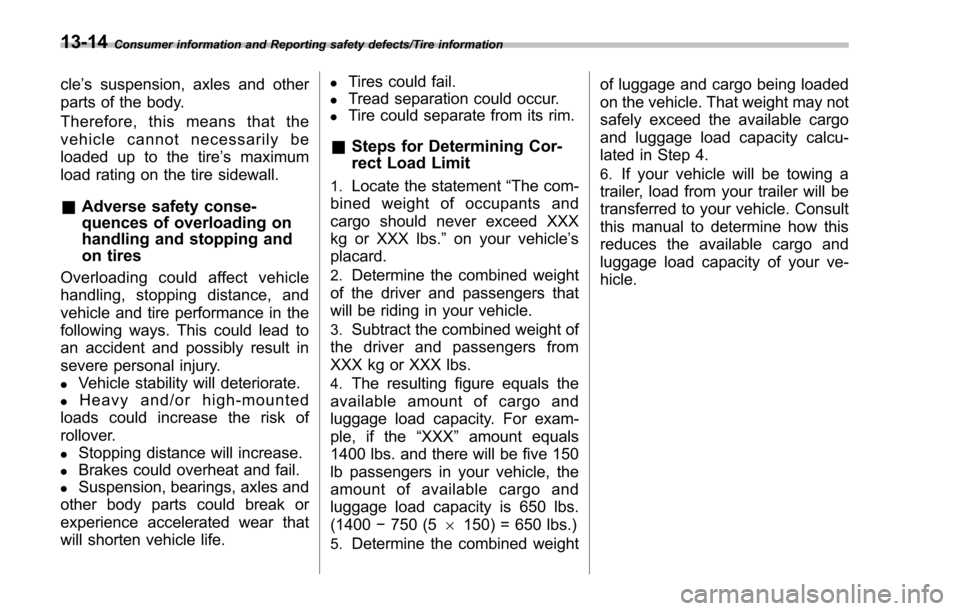
Consumer information and Reporting safety defects/Tire information
cle’s suspension, axles and other
parts of the body.
Therefore, this means that the
vehicle cannot necessarily be
loaded up to the tire ’s maximum
load rating on the tire sidewall.
& Adverse safety conse-
quences of overloading on
handling and stopping and
on tires
Overloading could affect vehicle
handling, stopping distance, and
vehicle and tire performance in the
following ways. This could lead to
an accident and possibly result in
severe personal injury.
.Vehicle stability will deteriorate.
.Heavy and/or high-mounted
loads could increase the risk of
rollover.
.Stopping distance will increase.
.Brakes could overheat and fail.
.Suspension, bearings, axles and
other body parts could break or
experience accelerated wear that
will shorten vehicle life.
.Tires could fail.
.Tread separation could occur.
.Tire could separate from its rim.
& Steps for Determining Cor-
rect Load Limit
1.Locate the statement “The com-
bined weight of occupants and
cargo should never exceed XXX
kg or XXX lbs. ”on your vehicle ’s
placard.
2.Determine the combined weight
of the driver and passengers that
will be riding in your vehicle.
3.Subtract the combined weight of
the driver and passengers from
XXX kg or XXX lbs.
4.The resulting figure equals the
available amount of cargo and
luggage load capacity. For exam-
ple, if the “XXX ”amount equals
1400 lbs. and there will be five 150
lb passengers in your vehicle, the
amount of available cargo and
luggage load capacity is 650 lbs.
(1400 −750 (5 6150) = 650 lbs.)
5.Determine the combined weight of luggage and cargo being loaded
on the vehicle. That weight may not
safely exceed the available cargo
and luggage load capacity calcu-
lated in Step 4.
6.If your vehicle will be towing a
trailer, load from your trailer will be
transferred to your vehicle. Consult
this manual to determine how this
reduces the available cargo and
luggage load capacity of your ve-
hicle.
13-14
Page 583 of 594

14-6Index
High beam indicator light............................................ 3-31
High/low beam change (dimmer) .................................. 3-91
Hill start assist .................................................. 7-41, 11-19
OFF indicator light .................................................. 3-23
Warning light ......................................................... 3-22
HomeLink
®.............................................................. 3-102
Hook Cargo tie-down ...................................................... 6-14
Coat ..................................................................... 6-11
Shopping bag ........................................................ 6-12
Towing and tie-down ............................................... 9-14
Horn ........................................................................\
3-111
Hose and connections ............................................... 11-11
I
Ignition switch .............................................................. 3-4
Light ....................................................................... 3-6
Illumination brightness control ...................................... 3-93
Immobilizer. ................................................................. 2-3
Indicator light (security indicator light) ....................... 3-30
Indicator light BSD/RCTA OFF. .................................................... 3-32
BSD/RCTA warning ................................................ 3-32
Coolant temperature low ......................................... 3-17
Cruise control ........................................................ 3-31
Cruise control set ................................................... 3-31
Front fog light ........................................................ 3-31
Headlight .............................................................. 3-32
High beam ............................................................ 3-31
Hill start assist OFF ................................................ 3-23
Immobilizer. ........................................................... 3-30 Security
................................................................. 3-30
Select lever/Gear position ........................................ 3-30
Steering responsive fog lights OFF ... ........................ 3-32
Turn signal ............................................................ 3-31
Vehicle Dynamics Control OFF ................................. 3-25
Vehicle Dynamics Control operation .......................... 3-24
Information display ...................................................... 3-32
Inside mirror .................................................. 3- 100, 3-102
Interior lights ............................................................... 6-2
Internal trunk lid release handle .................................... 2-39
J
Jack-up point .............................................................. 9-6
Jump starting ............................................................. 9-10
K
Key........................................................................\
.... 2-3 Number plate .......................................................... 2-3
Reminder chime ...................................................... 3-5
Replacement. .......................................................... 2-4
Keyless access entry function ...................................... 2-13
Keyless access with push-button start system ................. 2-9
Disabling keyless access functions ........................... 2-18
Locking and unlocking doors .................................... 2-13
Opening rear gate .................................................. 2-16
Opening trunk ........................................................ 2-16
Warning chimes and warning indicator ...................... 3-25
When access key does not operate properly .............. 9-18
Keyless entry system .................................................. 2-23
Page 587 of 594
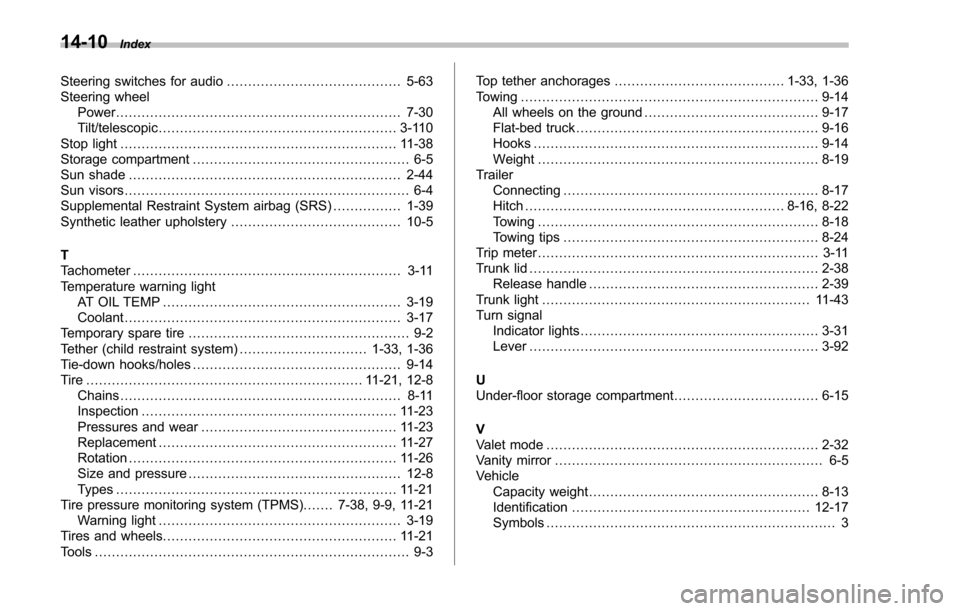
14-10Index
Steering switches for audio......................................... 5-63
Steering wheel Power ................................................................... 7-30
Tilt/telescopic ........................................................ 3-110
Stop light ................................................................. 11-38
Storage compartment ................................................... 6-5
Sun shade ................................................................ 2-44
Sun visors ................................................................... 6-4
Supplemental Restraint System airbag (SRS) ................ 1-39
Synthetic leather upholstery ........................................ 10-5
T
Tachometer ............................................................... 3-11
Temperature warning light AT OIL TEMP ........................................................ 3-19
Coolant ................................................................. 3-17
Temporary spare tire .................................................... 9-2
Tether (child restraint system) .............................. 1-33, 1-36
Tie-down hooks/holes ................................................. 9-14
Tire ................................................................. 11-21, 12-8 Chains .................................................................. 8-11
Inspection ............................................................ 11-23
Pressures and wear .............................................. 11-23
Replacement ........................................................ 11-27
Rotation ............................................................... 11-26
Size and pressure .................................................. 12-8
Types .................................................................. 11-21
Tire pressure monitoring system (TPMS). ...... 7-38, 9-9, 11-21
Warning light ......................................................... 3-19
Tires and wheels. ...................................................... 11-21
Tools ........................................................................\
.. 9-3 Top tether anchorages
........................................ 1-33, 1-36
Towing ...................................................................... 9-14
All wheels on the ground ......................................... 9-17
Flat-bed truck ......................................................... 9-16
Hooks ................................................................... 9-14
Weight .................................................................. 8-19
Trailer Connecting ............................................................ 8-17
Hitch ............................................................. 8-16, 8-22
Towing .................................................................. 8-18
Towing tips ............................................................ 8-24
Trip meter .................................................................. 3-11
Trunk lid .................................................................... 2-38
Release handle ...................................................... 2-39
Trunk light ............................................................... 11-43
Turn signal
Indicator lights ........................................................ 3-31
Lever .................................................................... 3-92
U
Under-floor storage compartment .................................. 6-15
V
Valet mode ................................................................ 2-32
Vanity mirror ............................................................... 6-5
Vehicle
Capacity weight ...................................................... 8-13
Identification ........................................................ 12-17
Symbols ....................................................................
3